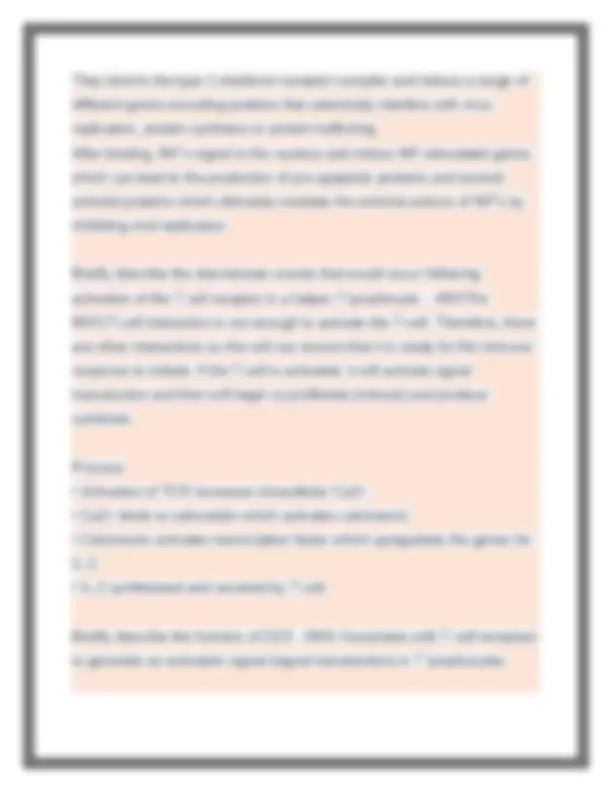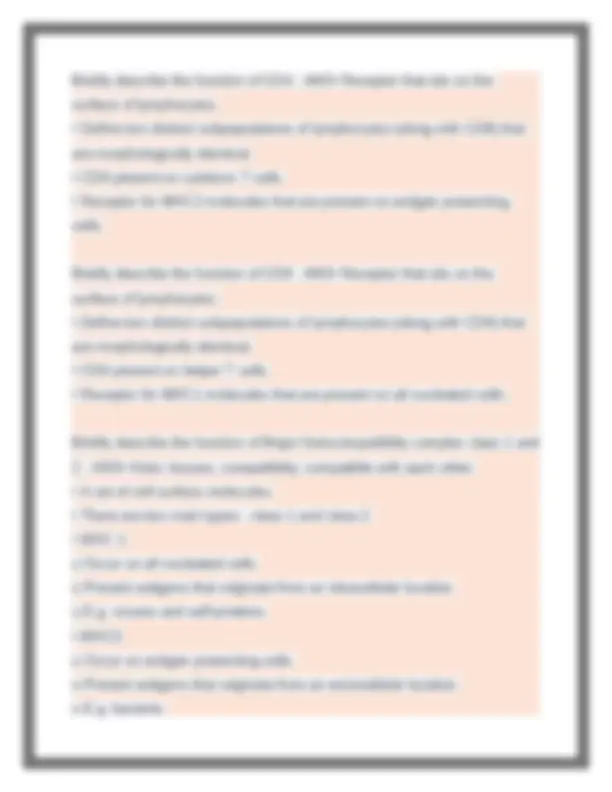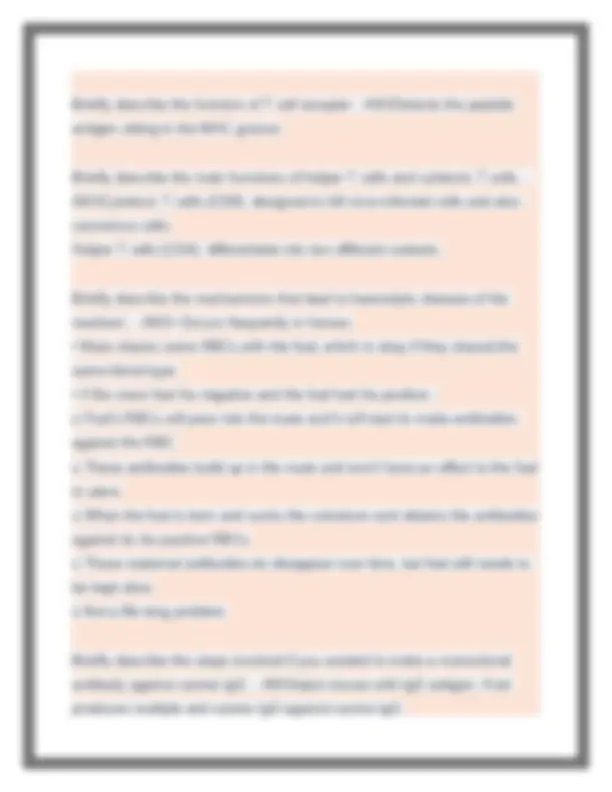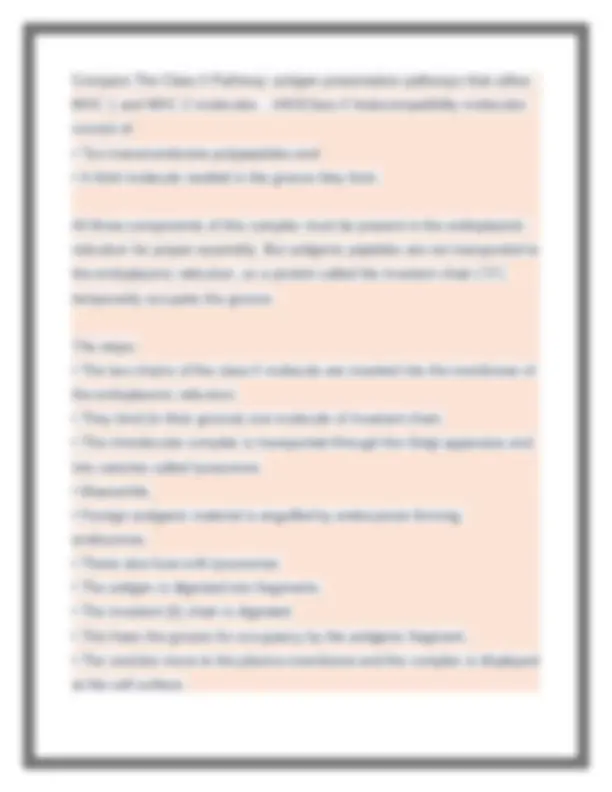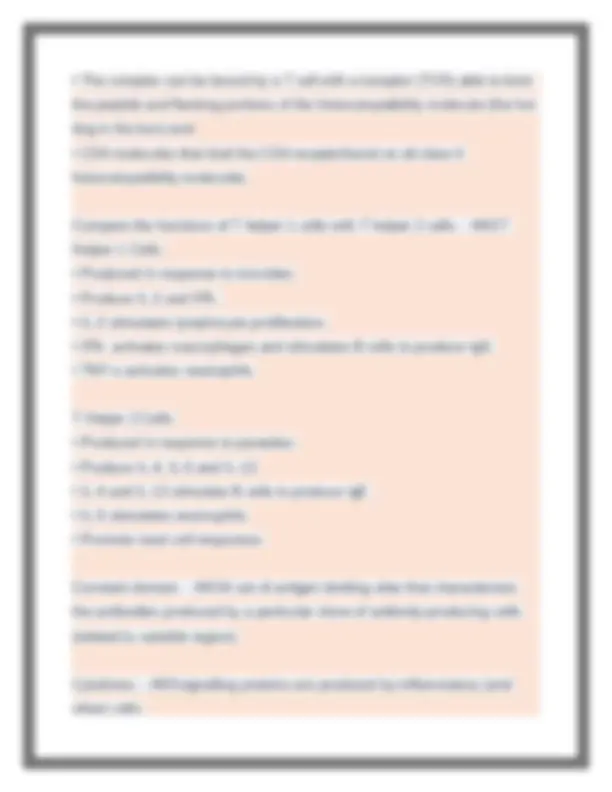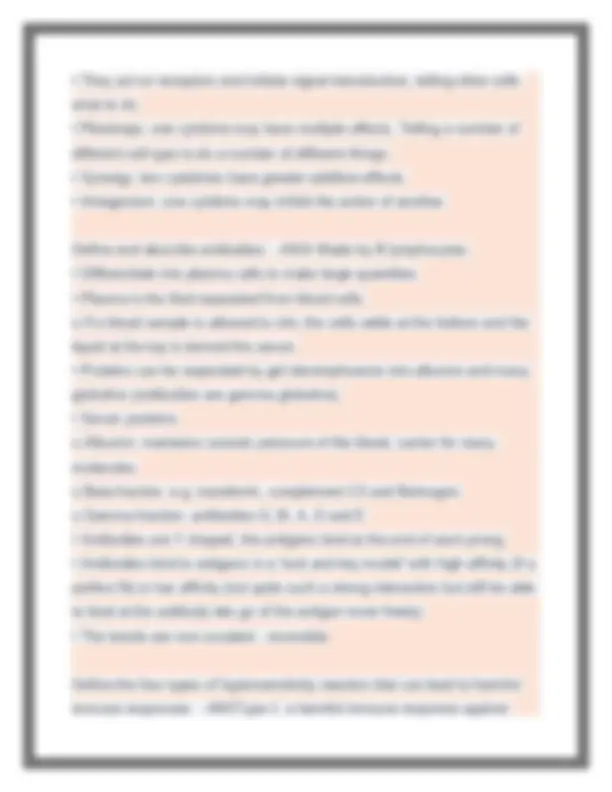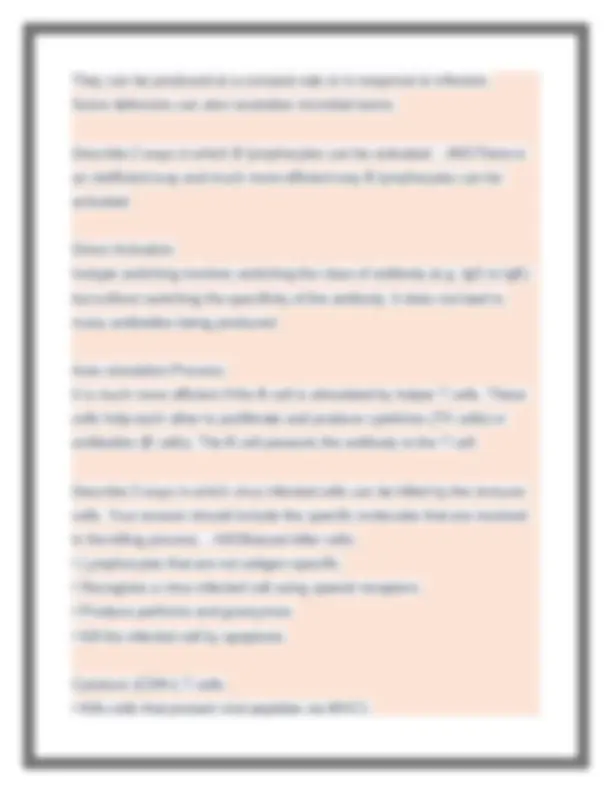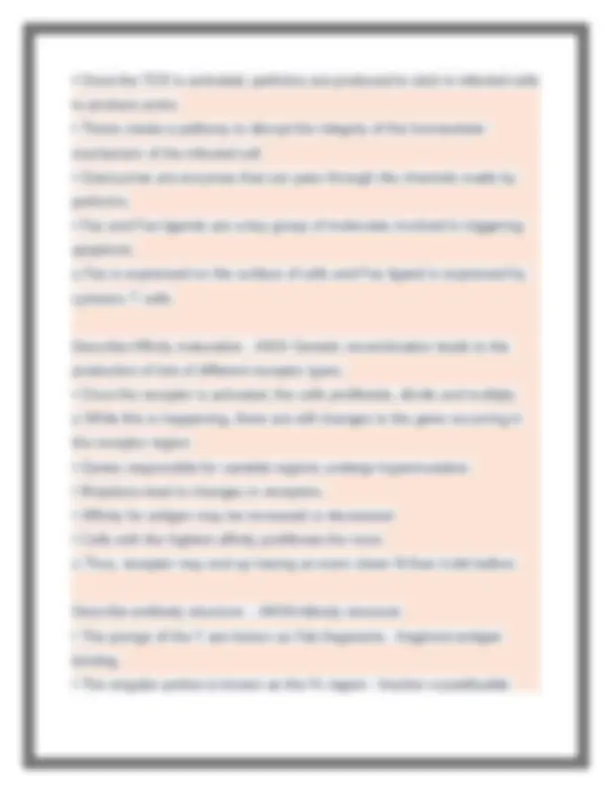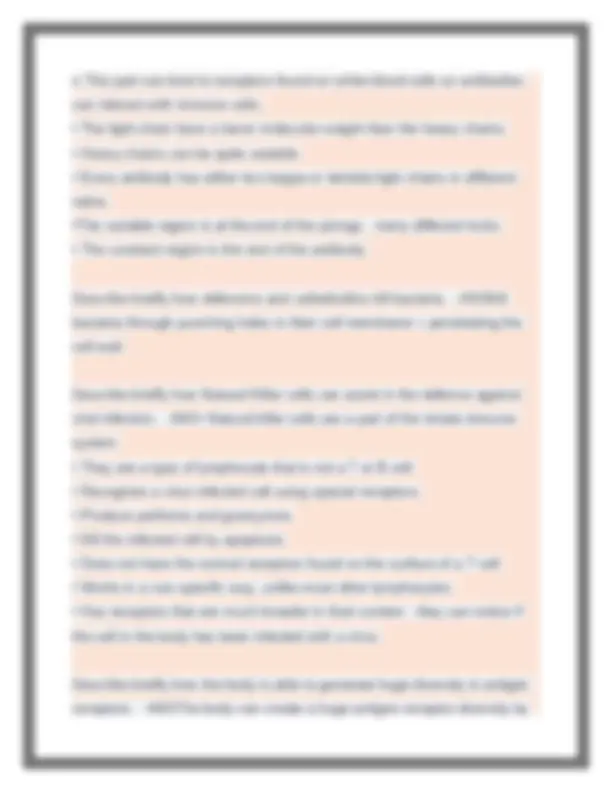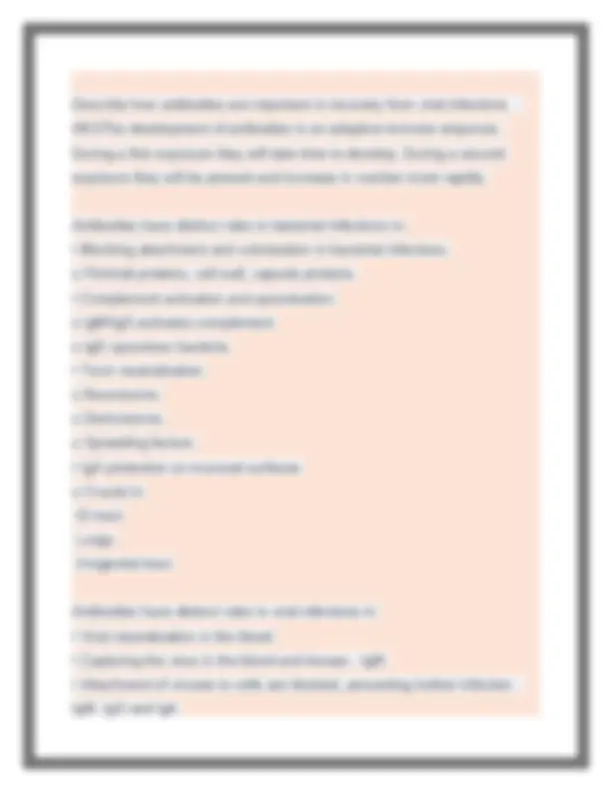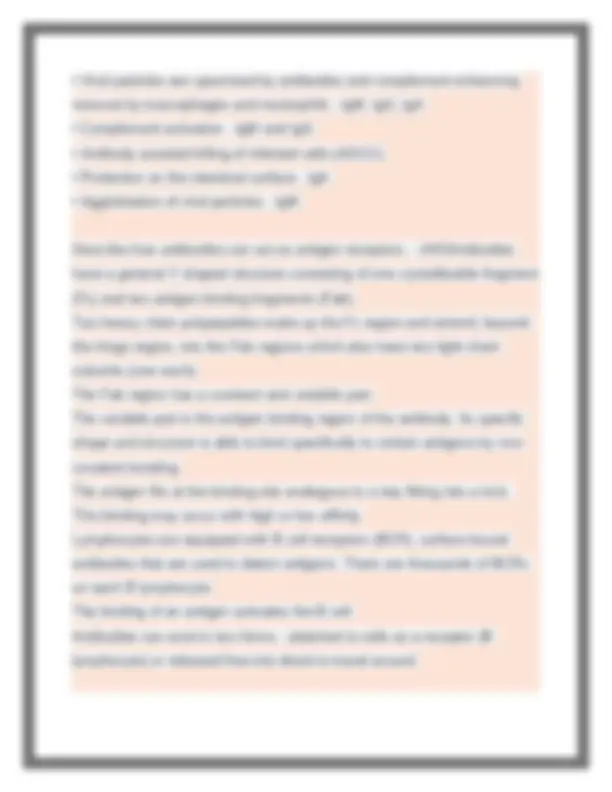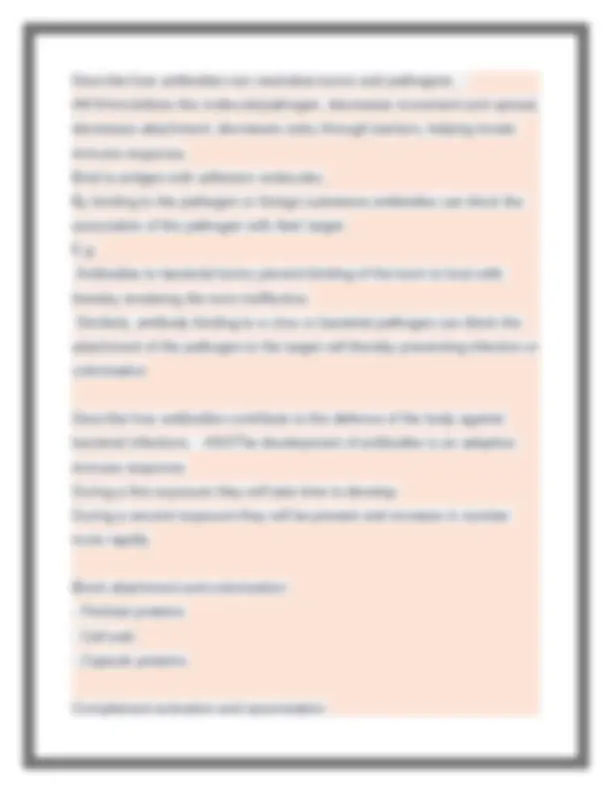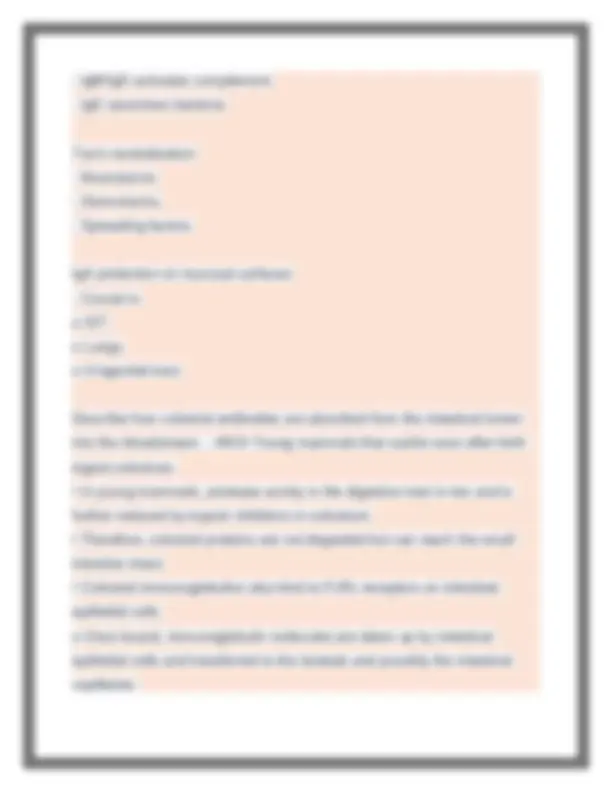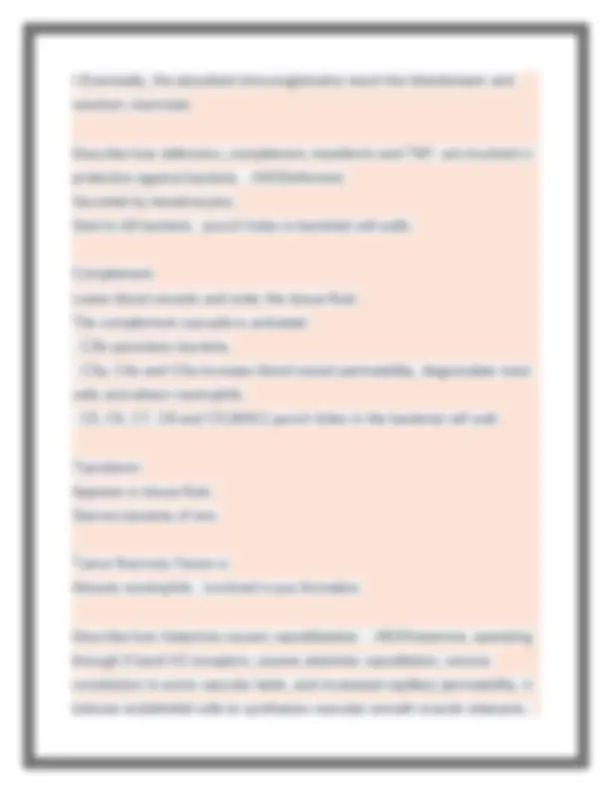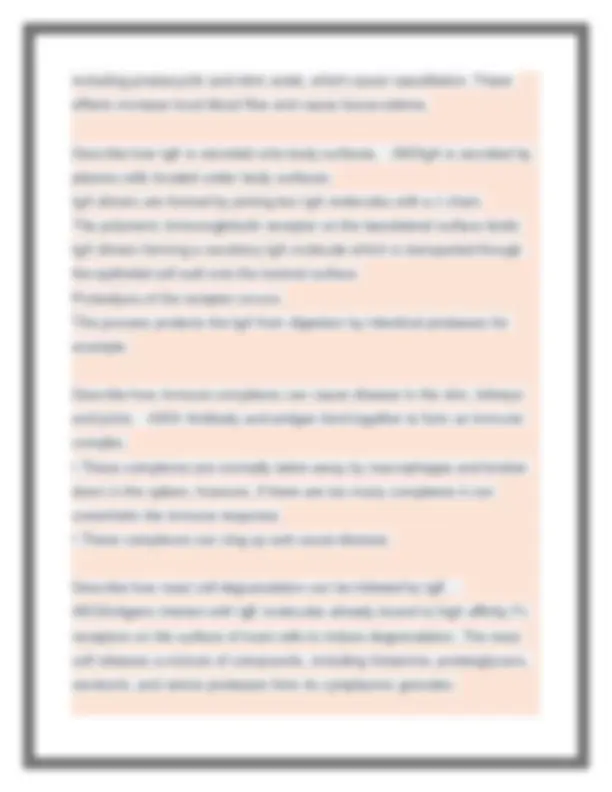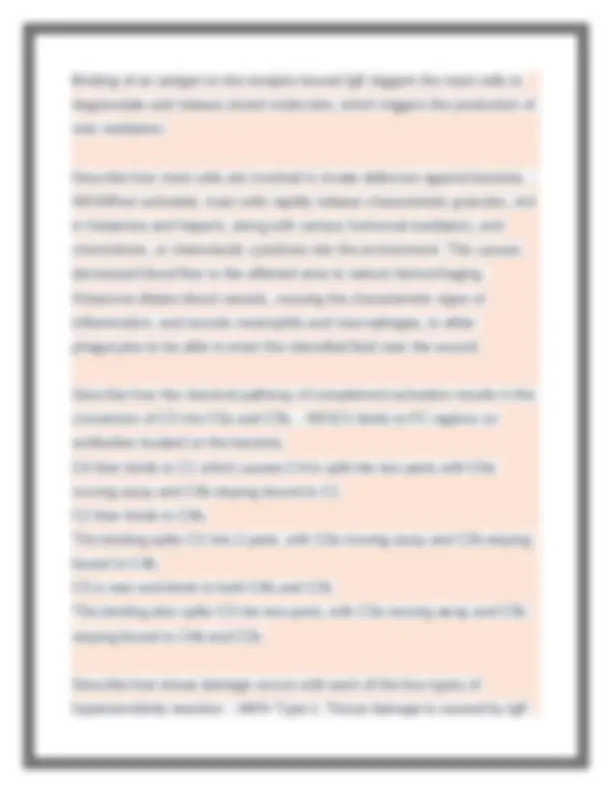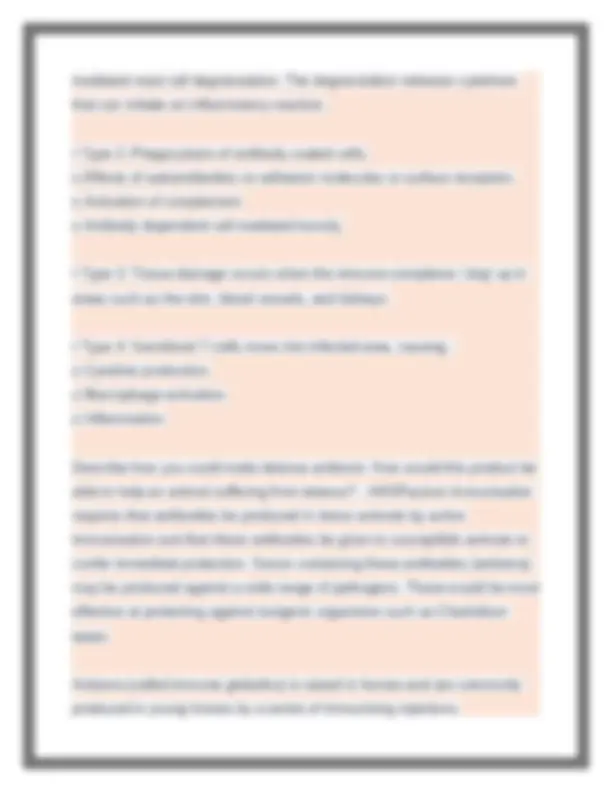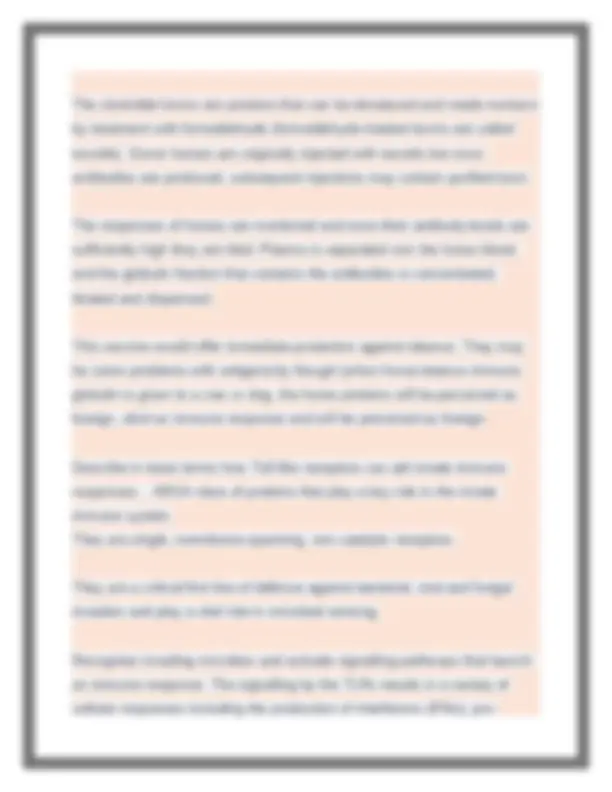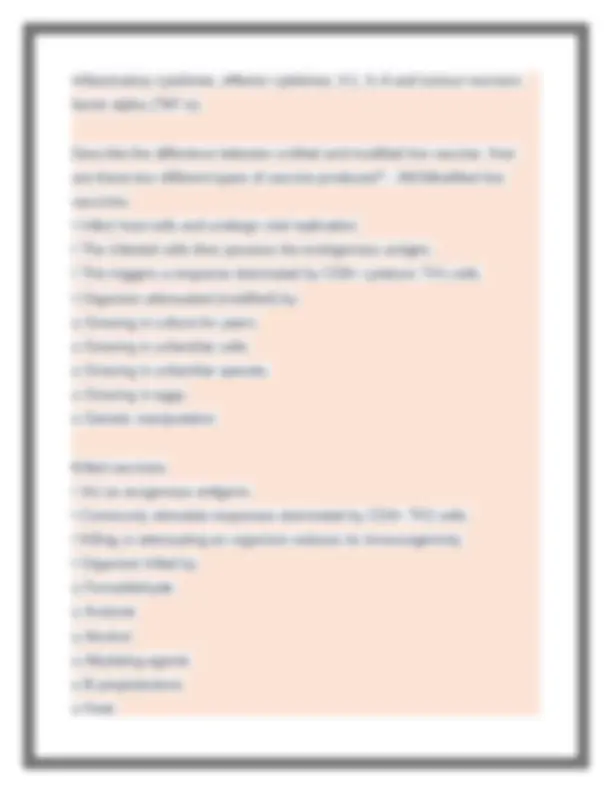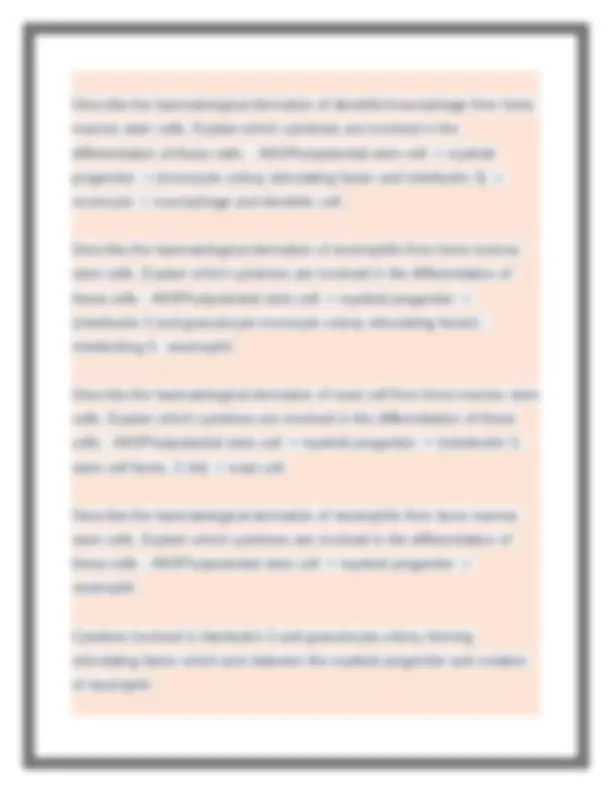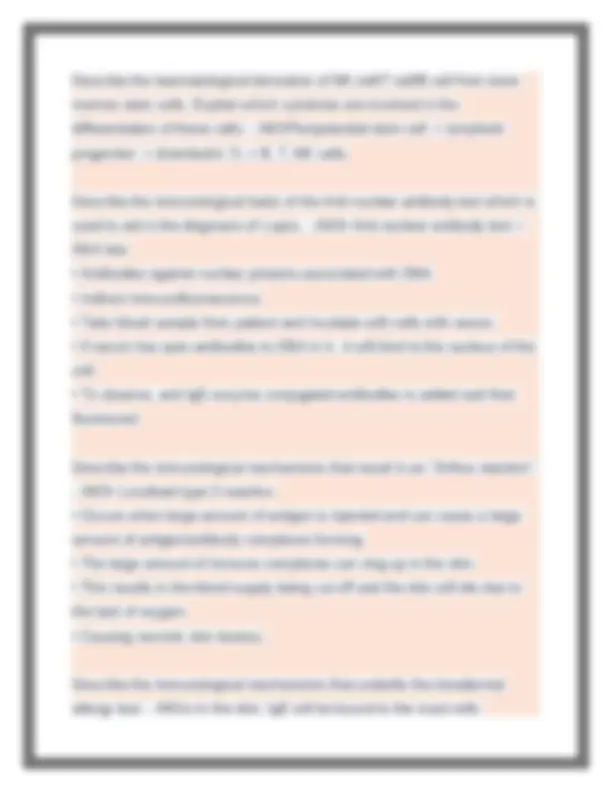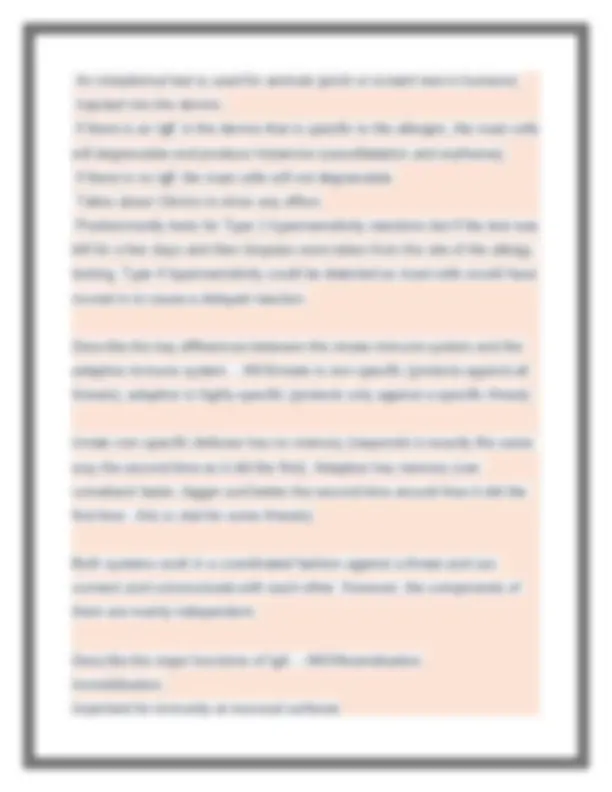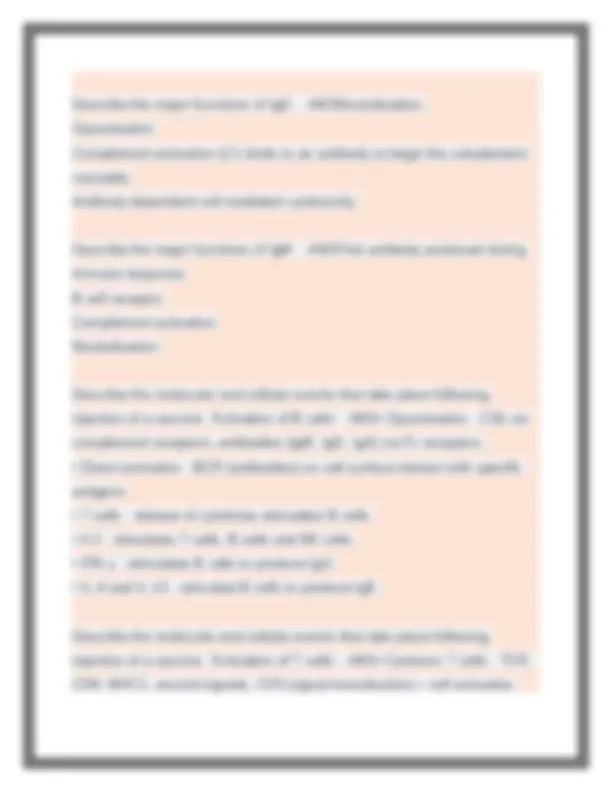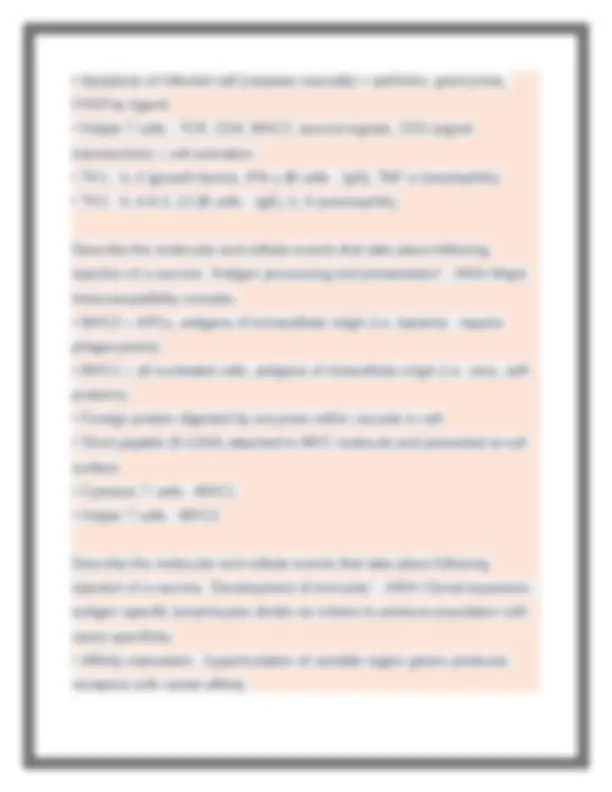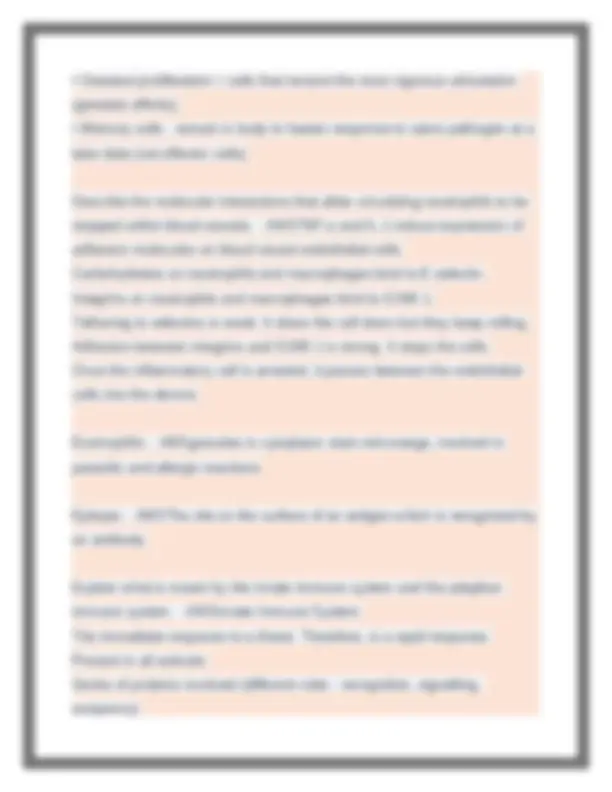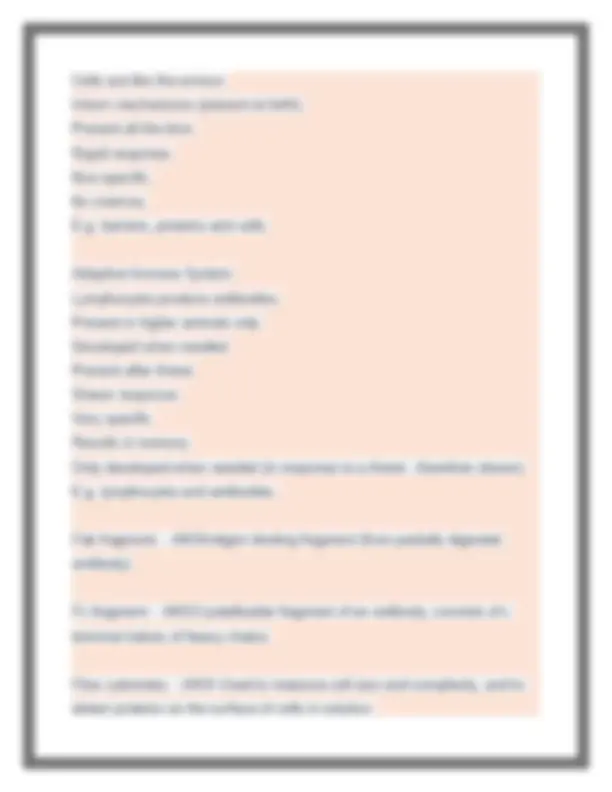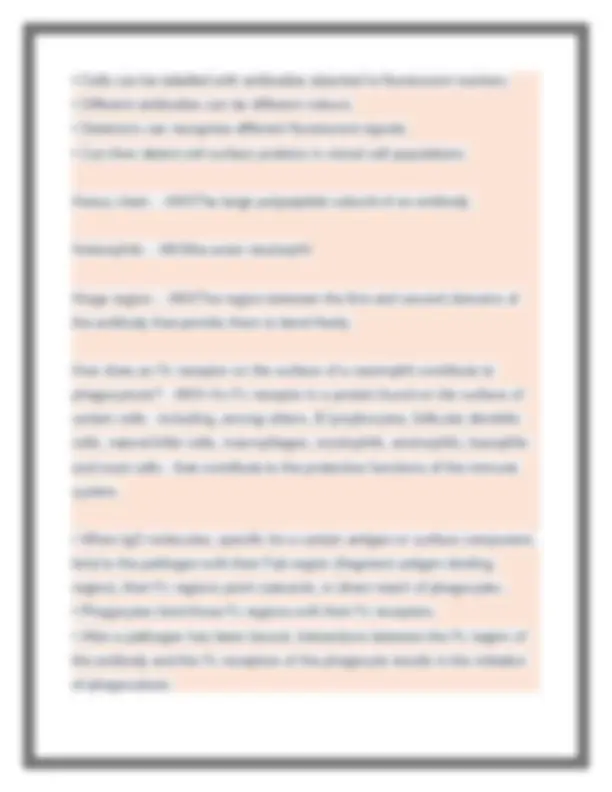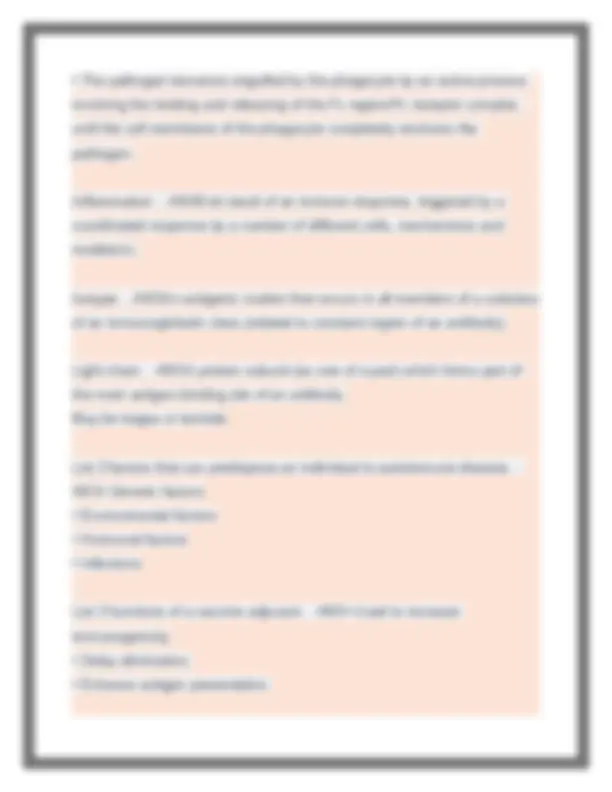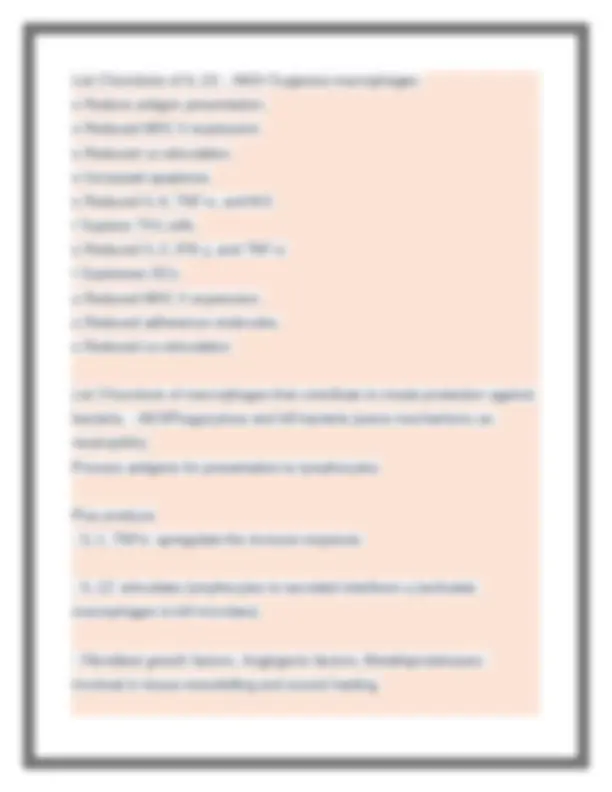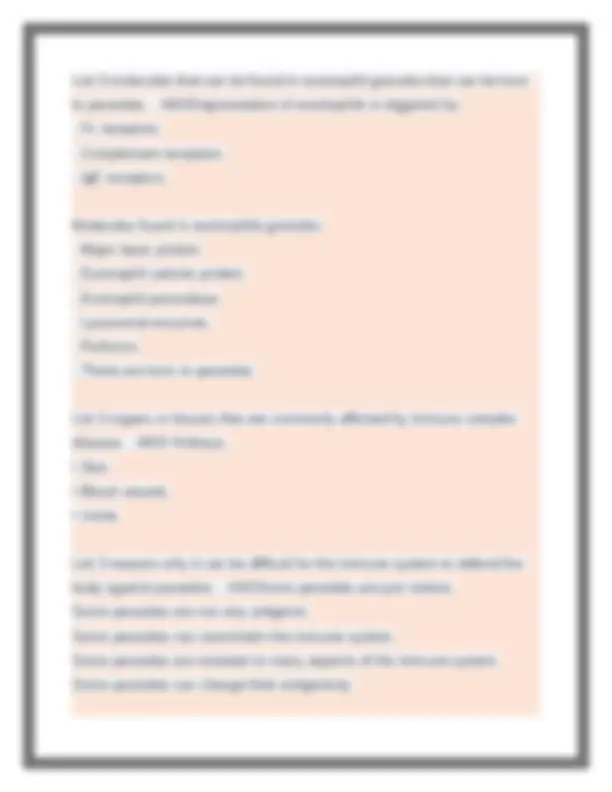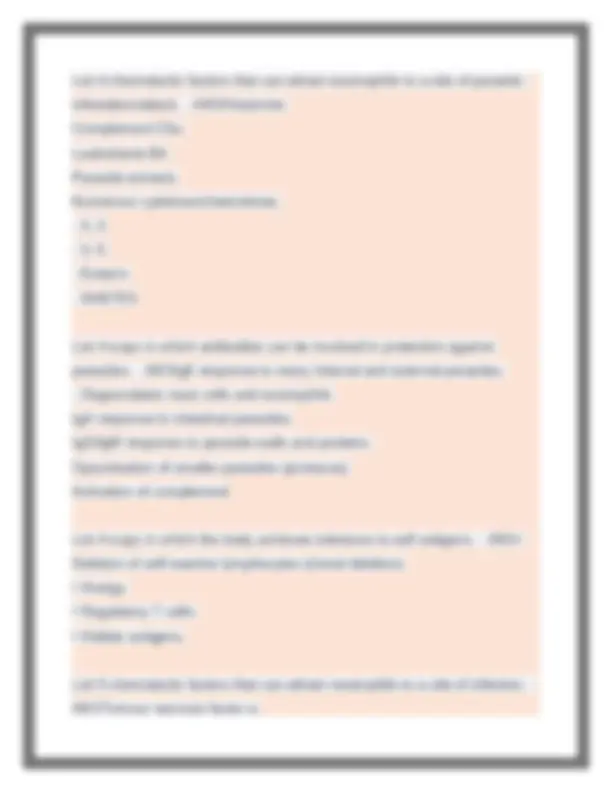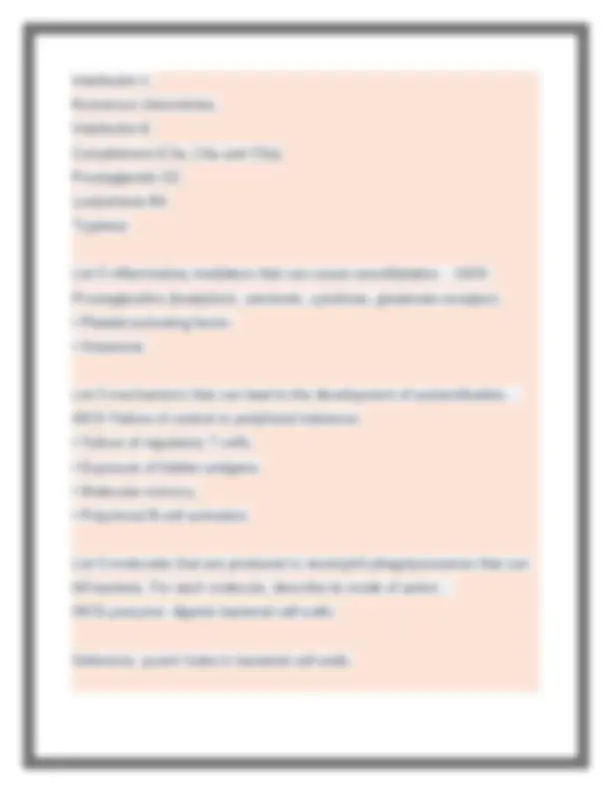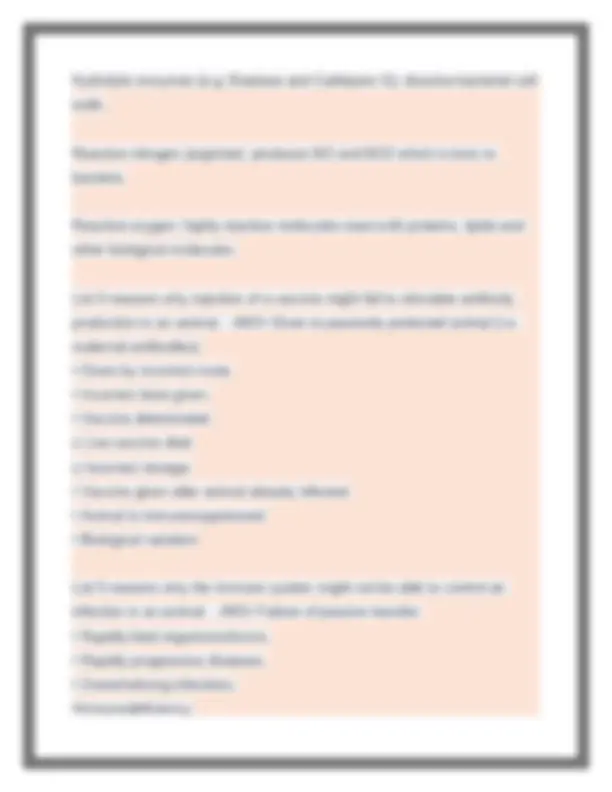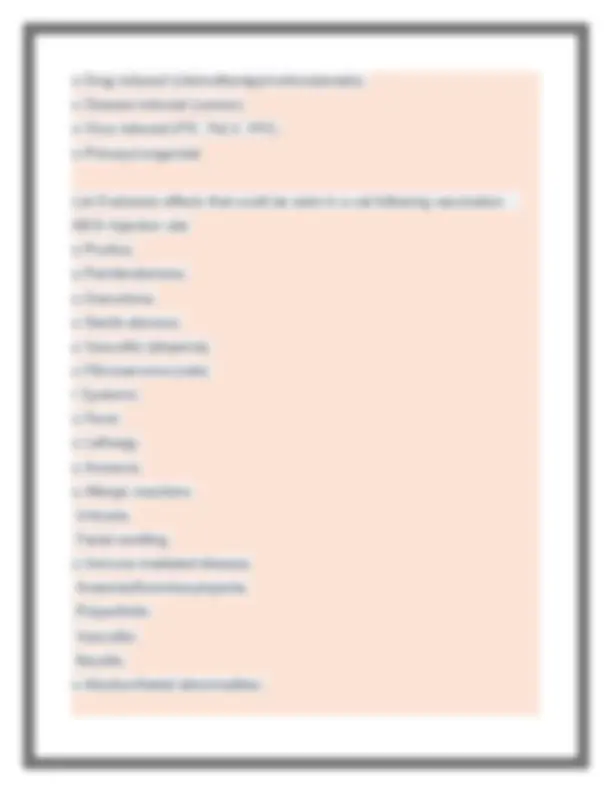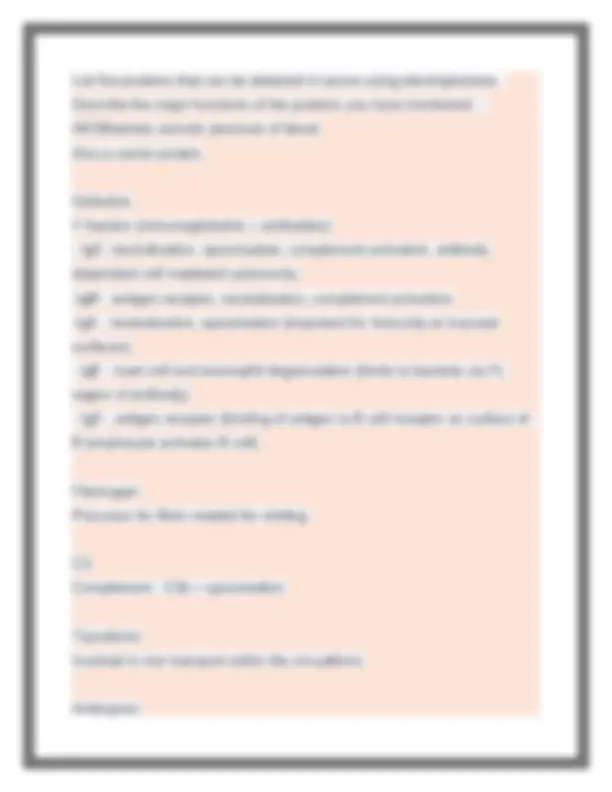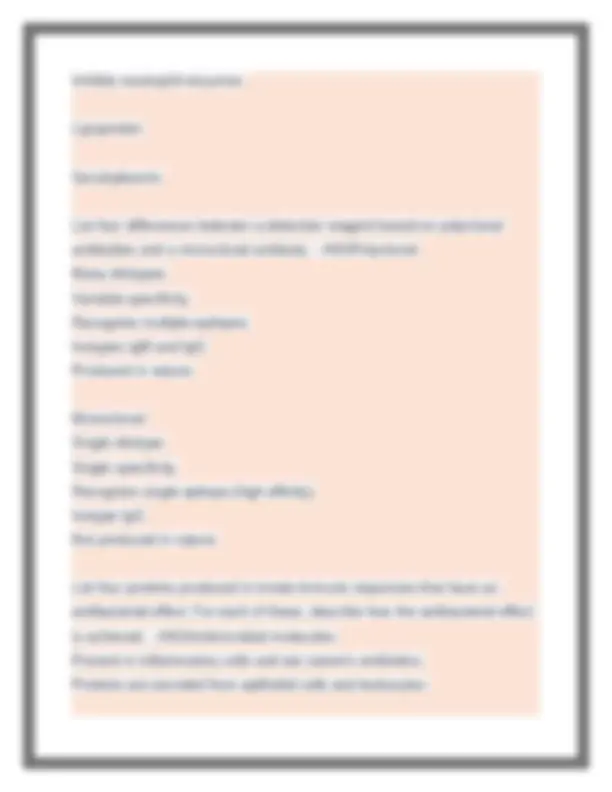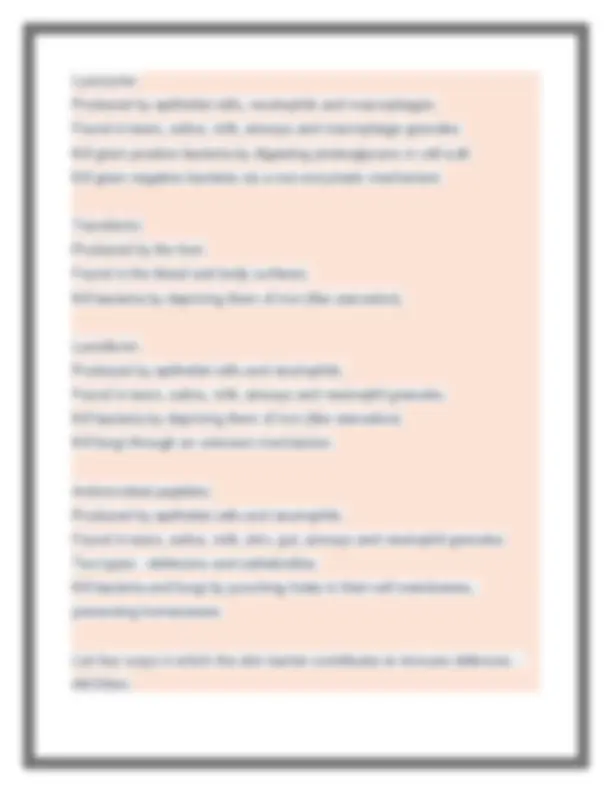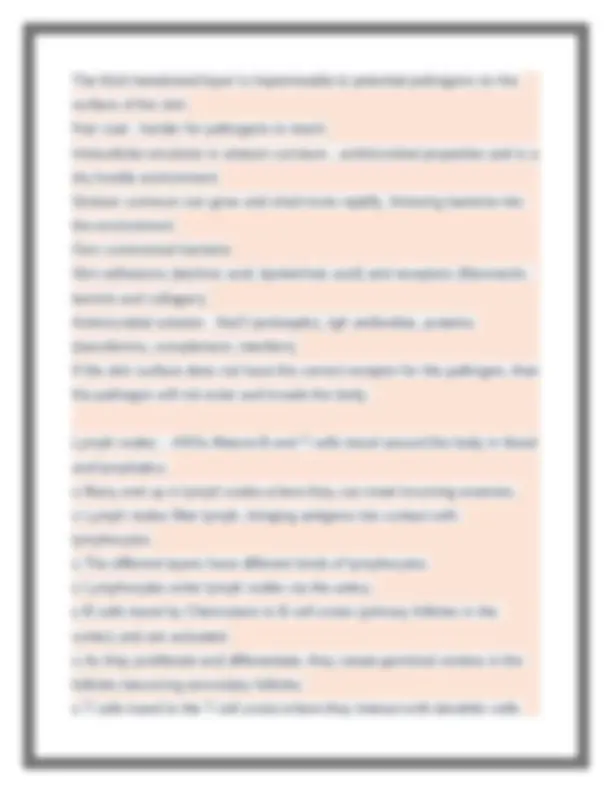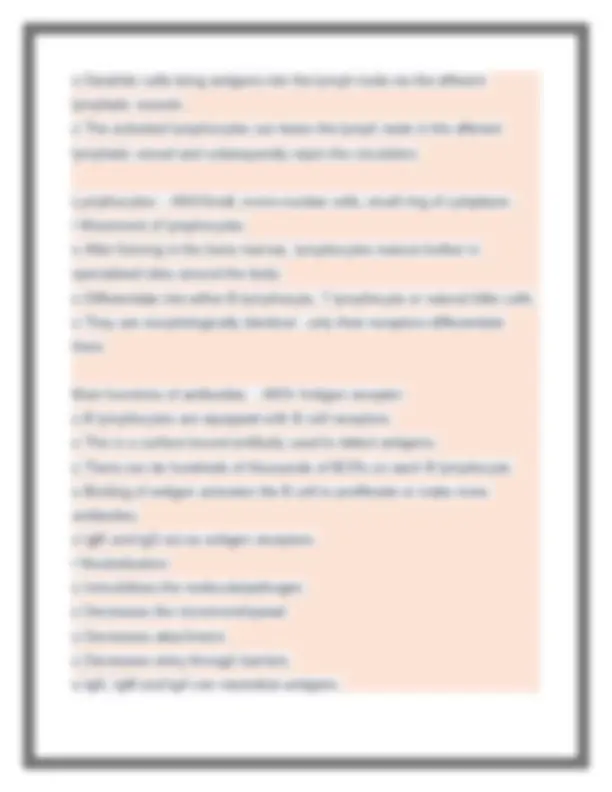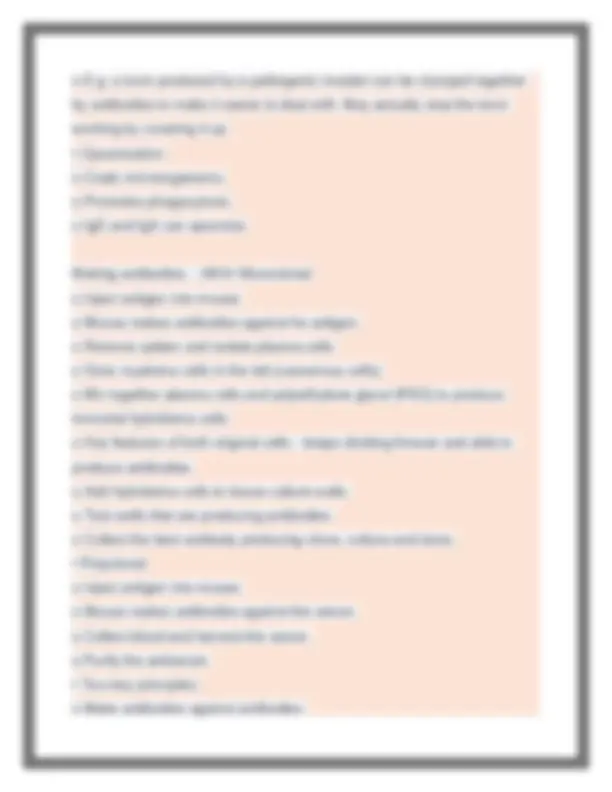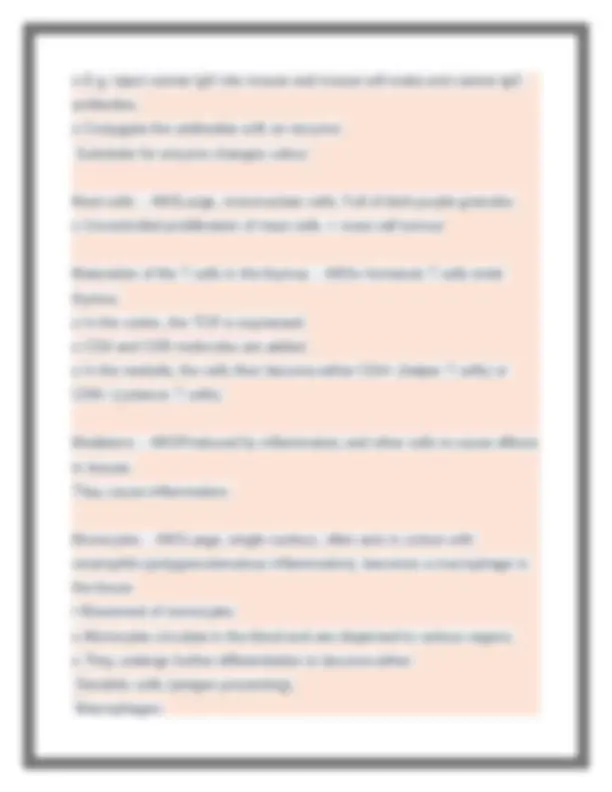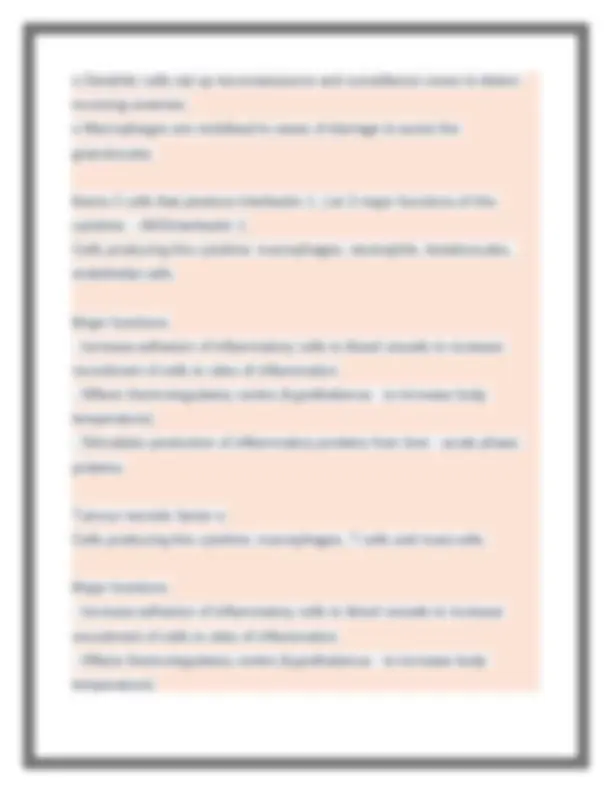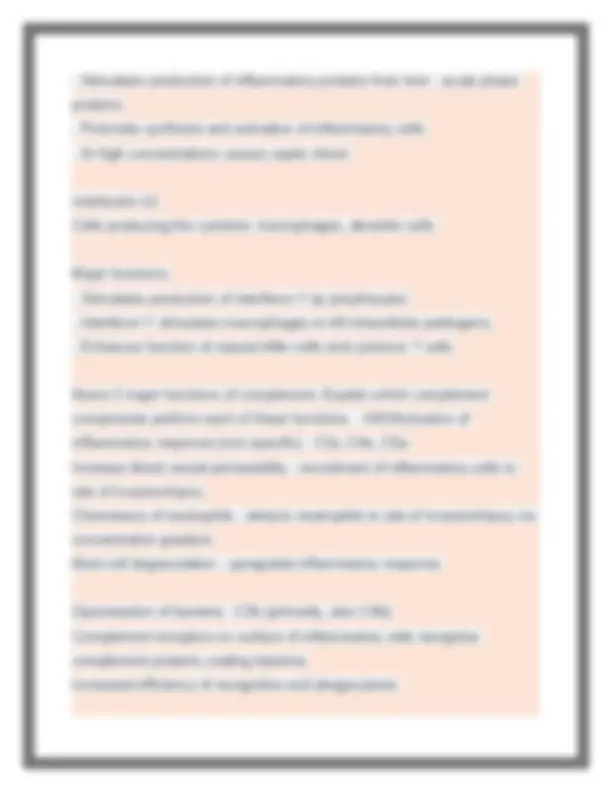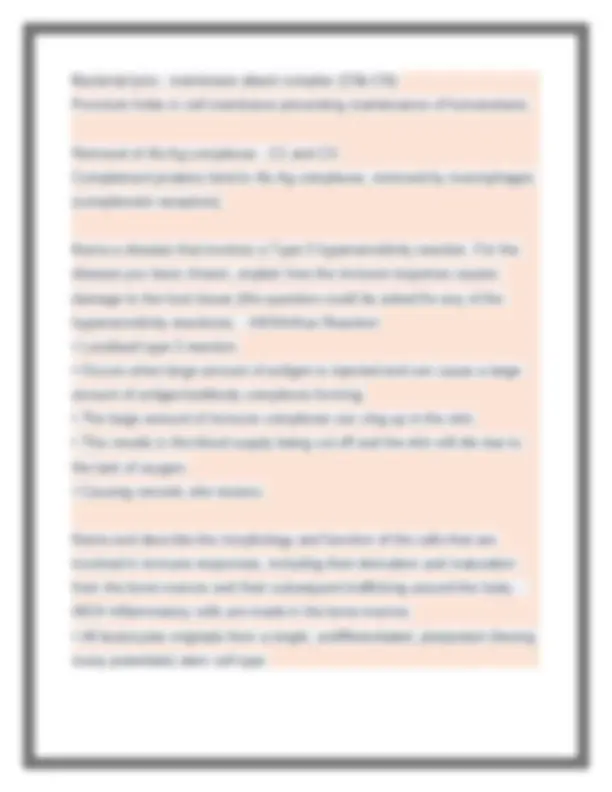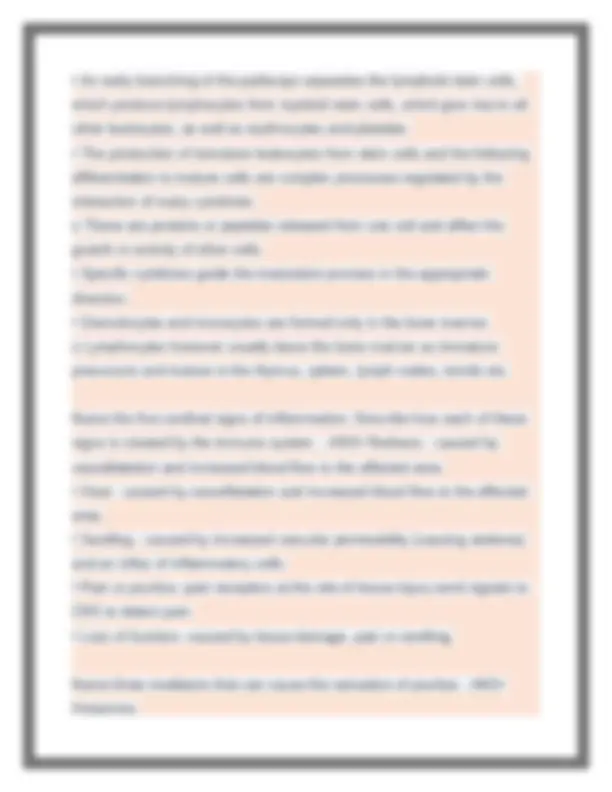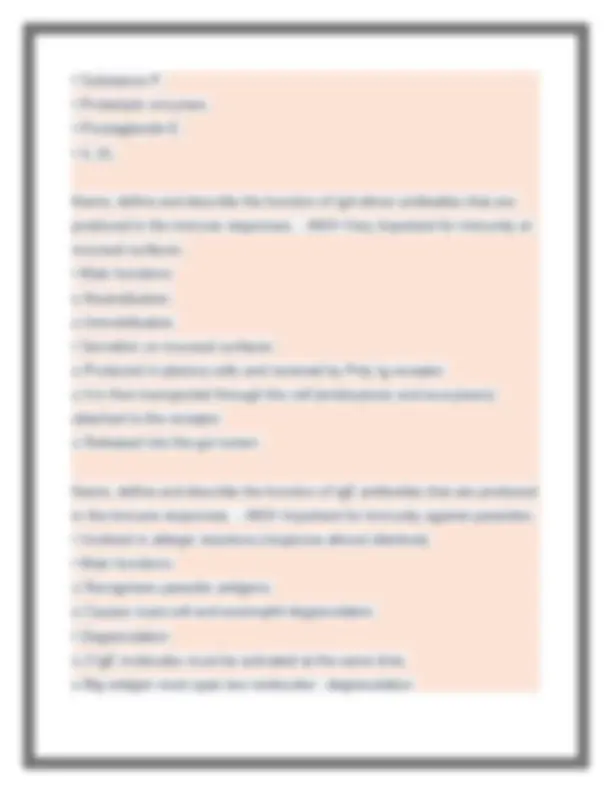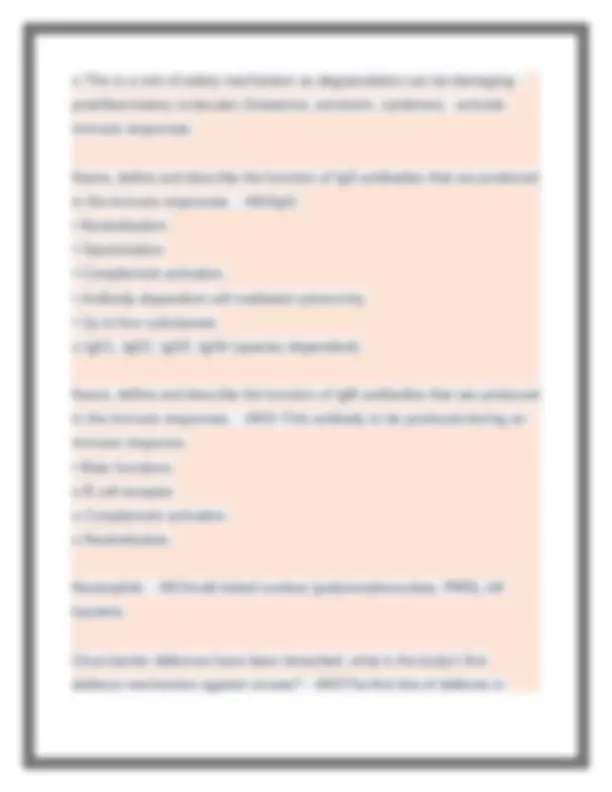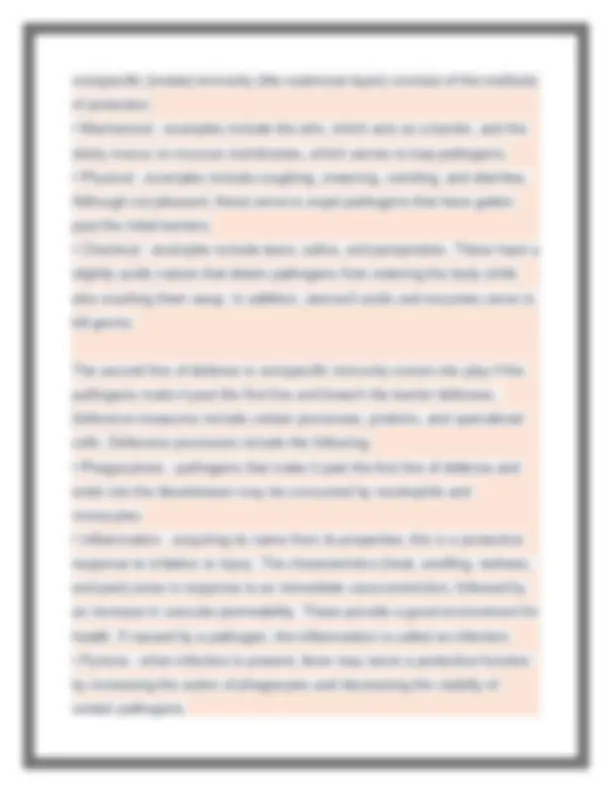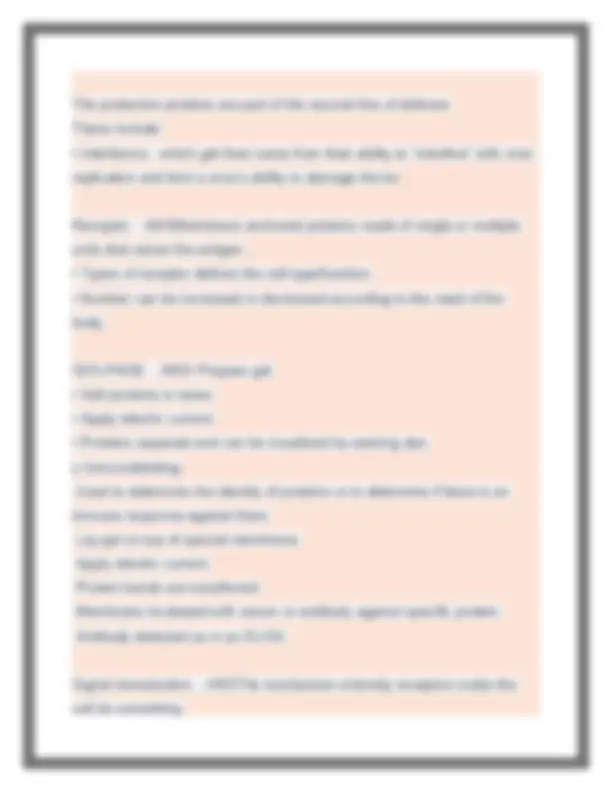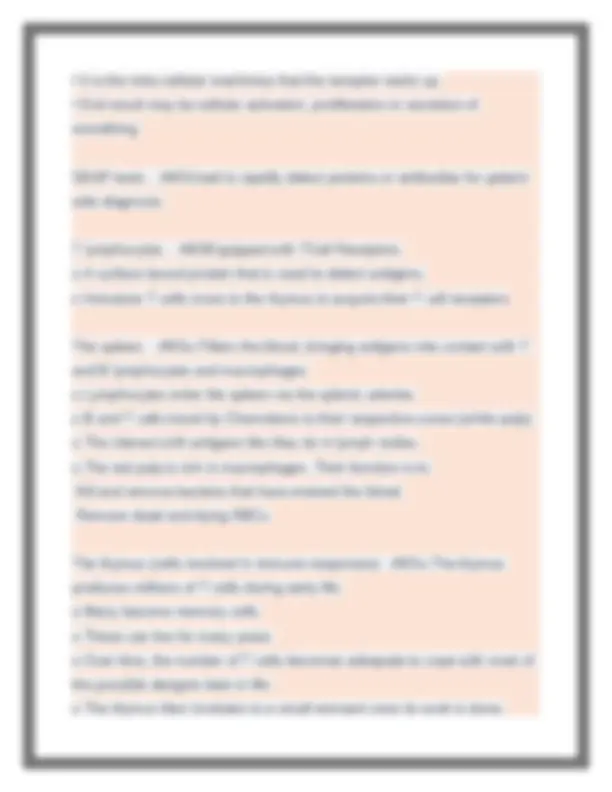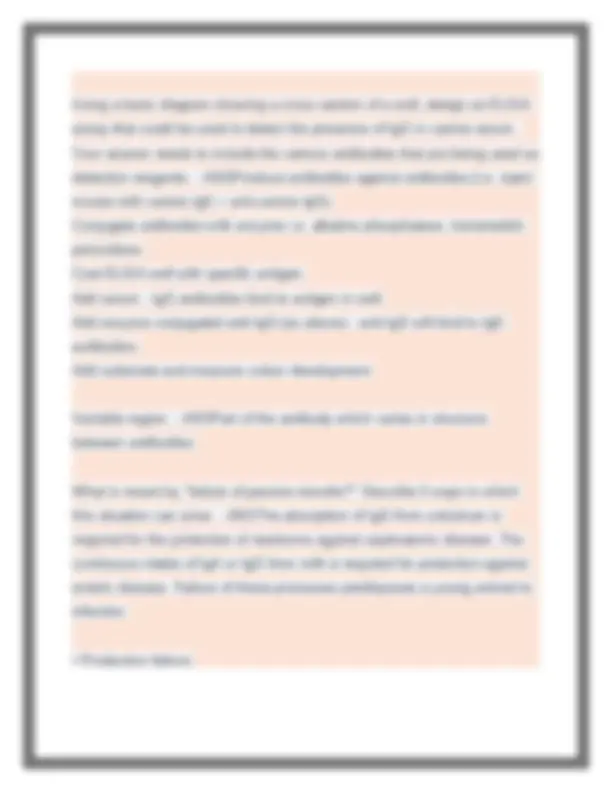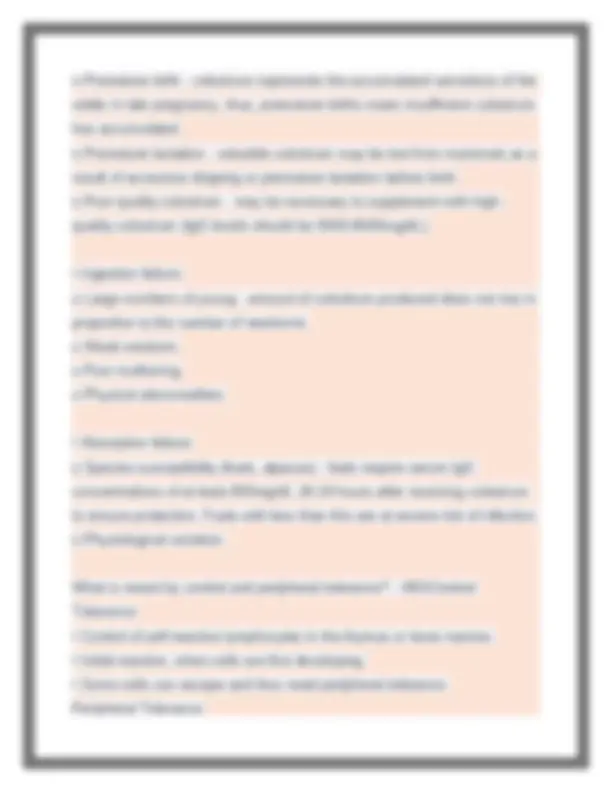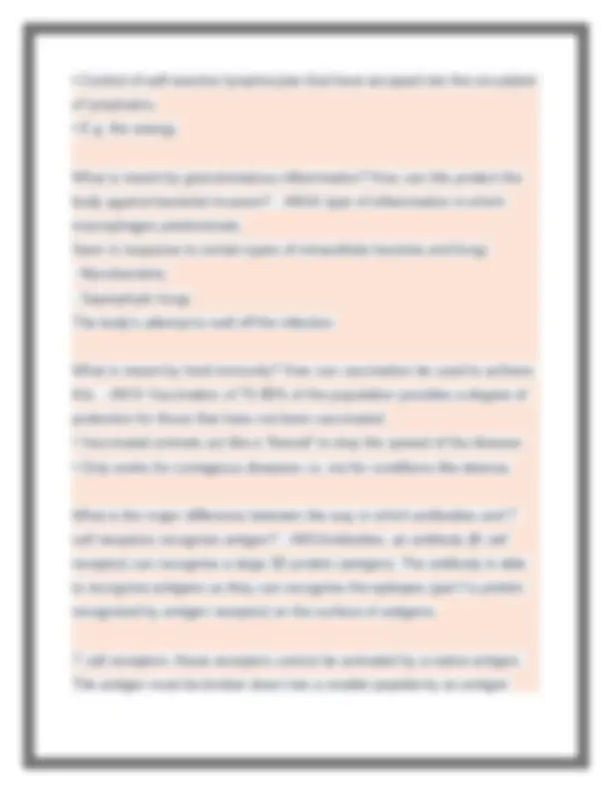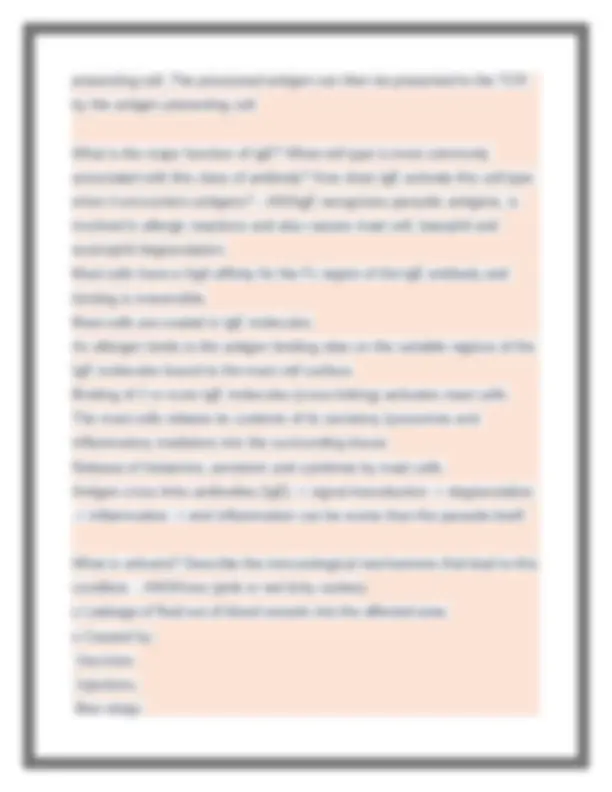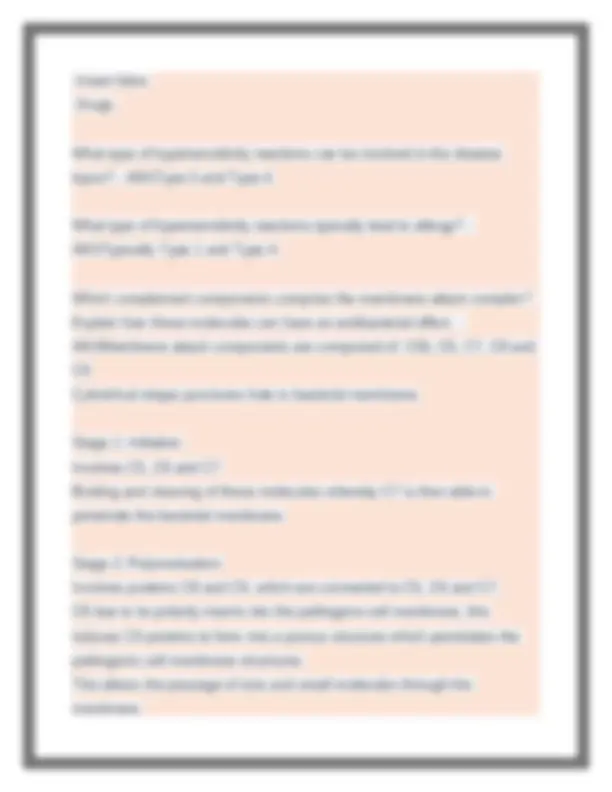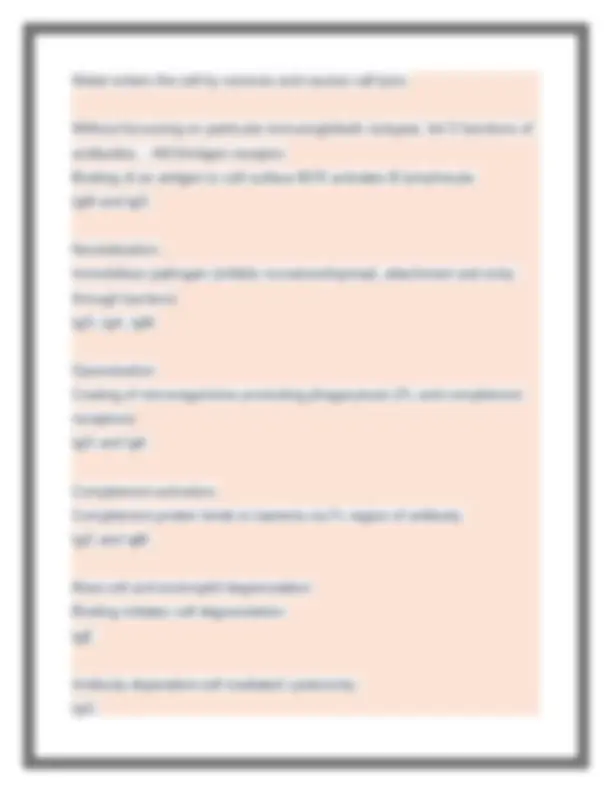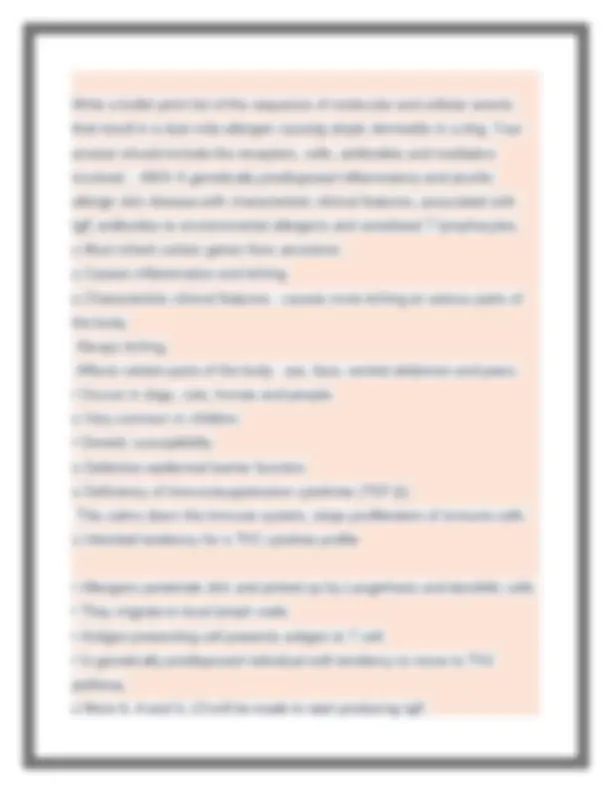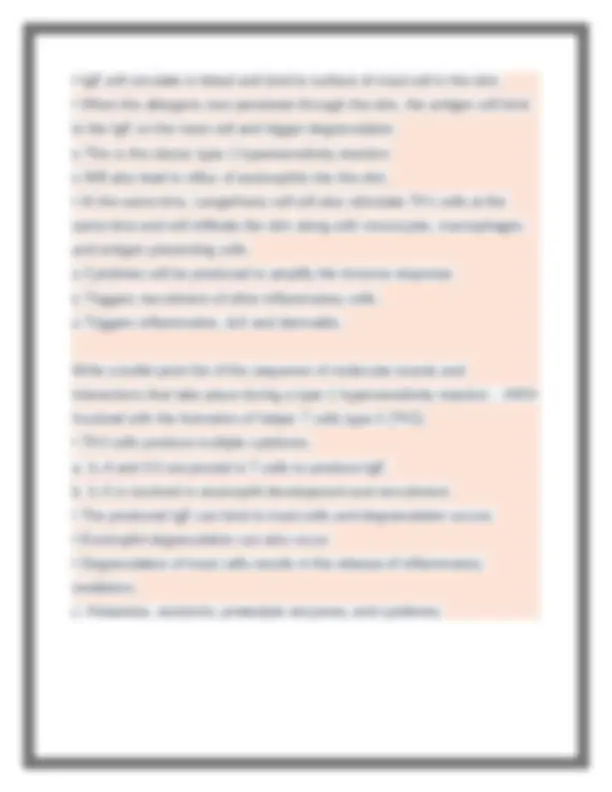Download VIID – Immunology Test Bank Study Questions and Answers Latest 2025 and more Exams Immunology in PDF only on Docsity!
VIID – Immunology Test Bank Study
Questions and Well Researched
Answers Latest Edition 2025-
Graded A
Affinity: - ANSThe strength of binding between antigen and antibody e.g. high or low. Anergy: - ANSFunctional unresponsiveness. Without a secondary signal or sufficient antigen, the lymphocytes will not respond. Antibody: - ANSY shaped proteins produced by lymphocytes.
- Exist in two forms: attached to the cell and free in blood and tissues.
- They bind to and remove antigens. Antigen: - ANSProteins that activate an immune response by stimulating immune cells.
- They bind to surface receptors.
- Microorganisms produce a lot of antigens, they are the enemy against which the body must be defended.
- The body distinguishes between self and foreign antigens B lymphocytes: - ANSEquipped with BCell Receptors. o This is a surface bound antibody used to detect antigens. o There can be hundreds of thousands of BCRs on each B lymphocyte.
o These BCRs bind to many antigens and the cells rapidly proliferate, producing more of the antibody and leading to the invader's destruction. Basophils - ANSContain vesicles that contain other substances including histamine and heparin. o Important in allergic reactions. o Rare in canines.
- Movement of granulocytes: o Neutrophils, eosinophils and basophils circulate in the blood until needed. o They are mobilised to danger zones such as: Areas of damage, Sites of infection, Parasitised tissues. Briefly describe how interferon- would be involved in the defence of the respiratory epithelium against a viral infection. - ANSInterferons have the ability to interfere with viral replication within a host cell. They can also activate immune cells such as natural killer cells and macrophages. They upregulate antigen presentation to T lymphocytes and increase ability of uninfected cells to resist infection. Interferon alpha is produced by leukocytes and involved in innate immune response against viral infections. In the respiratory system they are expressed by many epithelial cell types.
Briefly describe the function of CD4 - ANS• Receptor that sits on the surface of lymphocytes.
- Define two distinct subpopulations of lymphocytes (along with CD8) that are morphologically identical.
- CD4 present on cytotoxic T cells.
- Receptor for MHC2 molecules that are present on antigen presenting cells. Briefly describe the function of CD8 - ANS• Receptor that sits on the surface of lymphocytes.
- Define two distinct subpopulations of lymphocytes (along with CD4) that are morphologically identical.
- CD4 present on helper T cells.
- Receptor for MHC1 molecules that are present on all nucleated cells. Briefly describe the function of Major histocompatibility complex class 1 and 2 - ANS• Histo: tissues; compatibility: compatible with each other.
- A set of cell surface molecules.
- There are two main types - class 1 and class 2.
- MHC 1: o Occur on all nucleated cells. o Present antigens that originate from an intracellular location. o E.g. viruses and self-proteins.
- MHC2: o Occur on antigen presenting cells. o Present antigens that originate from an extracellular location. o E.g. bacteria.
Briefly describe the function of T cell receptor - ANSDetects the peptide antigen sitting in the MHC groove. Briefly describe the main functions of helper T cells and cytotoxic T cells. - ANSCytotoxic T cells (CD8): designed to kill virus-infected cells and also cancerous cells. Helper T cells (CD4): differentiate into two different subsets. Briefly describe the mechanisms that lead to haemolytic disease of the newborn. - ANS• Occurs frequently in horses.
- Mare shares some RBCs with the foal, which is okay if they shared the same blood type.
- If the mare had Aa negative and the foal had Aa positive - o Foal's RBCs will pass into the mare and it will start to make antibodies against the RBC. o These antibodies build up in the mare and won't have an effect to the foal in-utero. o When the foal is born and sucks the colostrum and obtains the antibodies against its Aa positive RBCs. o These maternal antibodies do disappear over time, but foal still needs to be kept alive. o Not a life-long problem. Briefly describe the steps involved if you wanted to make a monoclonal antibody against canine IgG. - ANSInject mouse with IgG antigen. Host produces multiple anti-canine IgG against canine IgG.
Epithelium acts as a barrier for entry - tight cell junction. Lungs: Mucous - trap inhaled pathogen, allergens, and irritants and easily transported out. Cilia - rhythmic ciliary beating moves mucous out. Epithelium - lung barrier. Coughing/sneezing helps force pathogens out of the body. Compare The Class I Pathway: antigen presentation pathways that utilise MHC 1 and MHC 2 molecules. - ANSClass I histocompatibility molecules are transmembrane proteins expressed at the cell surface. Like all transmembrane proteins, they are synthesized by ribosomes on the rough endoplasmic reticulum (RER) and assembled within its lumen. There are three subunits in each class I histocompatibility molecule:
- The transmembrane polypeptide (called the "heavy chain")
- The antigenic peptide
- Beta-2 microglobulin All of these must be present within the lumen of the endoplasmic reticulum if they are to assemble correctly and move through the Golgi apparatus to the cell surface. The Problem: proteins encoded by the genes of an infecting virus are synthesized in the cytosol.
Compare The Class II Pathway: antigen presentation pathways that utilise MHC 1 and MHC 2 molecules. - ANSClass II histocompatibility molecules consist of
- Two transmembrane polypeptides and
- A third molecule nestled in the groove they form. All three components of this complex must be present in the endoplasmic reticulum for proper assembly. But antigenic peptides are not transported to the endoplasmic reticulum, so a protein called the invariant chain ("Ii") temporarily occupies the groove. The steps:
- The two chains of the class II molecule are inserted into the membrane of the endoplasmic reticulum.
- They bind (in their groove) one molecule of invariant chain.
- This trimolecular complex is transported through the Golgi apparatus and into vesicles called lysosomes.
- Meanwhile,
- Foreign antigenic material is engulfed by endocytosis forming endosomes.
- These also fuse with lysosomes.
- The antigen is digested into fragments.
- The invariant (Ii) chain is digested.
- This frees the groove for occupancy by the antigenic fragment.
- The vesicles move to the plasma membrane and the complex is displayed at the cell surface.
- They act on receptors and initiate signal transduction, telling other cells what to do.
- Pleiotropy: one cytokine may have multiple effects. Telling a number of different cell type to do a number of different things.
- Synergy: two cytokines have greater additive effects.
- Antagonism: one cytokine may inhibit the action of another. Define and describe antibodies: - ANS• Made by B lymphocytes.
- Differentiate into plasma cells to make large quantities.
- Plasma is the fluid separated from blood cells. o If a blood sample is allowed to clot, the cells settle at the bottom and the liquid at the top is termed the serum.
- Proteins can be separated by gel electrophoresis into albumin and many globulins (antibodies are gamma globulins).
- Serum proteins: o Albumin: maintains osmotic pressure of the blood, carrier for many molecules. o Beta fraction: e.g. transferrin, complement C3 and fibrinogen. o Gamma fraction: antibodies G, M, A, D and E.
- Antibodies are Y shaped, the antigens bind at the end of each prong.
- Antibodies bind to antigens in a 'lock and key model' with high affinity (if a perfect fit) or low affinity (not quite such a strong interaction but still be able to bind at the antibody lets go of the antigen more freely).
- The bonds are non-covalent - reversible Define the four types of hypersensitivity reaction that can lead to harmful immune responses. - ANSType 1: a harmful immune response against
antigens involving the interaction between IgE and mast cell resulting in inflammation. Type 2: a harmful immune response that occurs as a result of binding of IgG or IgM antibodies to antigens on the surface of cells or associated structures (basement membranes, adhesion molecules), resulting in tissue malfunction or injury. Type 3: a harmful immune response involving the formation of antigen- antibody complexes that can exist free in the circulation or be deposited as microprecipitates in vascular beds, basement membranes or other tissues. Type 4: a harmful immune response caused by a population of sensitised T cells resulting in the influx of lymphocytes and macrophages. Define the term Fc receptor. - ANSFc receptor: Protein found on the surface of cells including B lymphocytes, natural killer cells, macrophages, neutrophils and mast cells. Binds to the Fc region on an antibody. Define the term opsonisation. Describe how antibodies are involved in opsonisation, and indicate how this process aids the innate immune system. - ANSProcess by which a pathogen is marked for ingestion/destruction by a phagocyte.
They can be produced at a constant rate or in response to infection. Some defensins can also neutralise microbial toxins. Describe 2 ways in which B lymphocytes can be activated: - ANSThere is an inefficient way and much more efficient way B lymphocytes can be activated. Direct Activation: Isotype switching involves switching the class of antibody (e.g. IgG to IgE) but without switching the specificity of the antibody. It does not lead to many antibodies being produced. Auto-simulation Process: It is much more efficient if the B cell is stimulated by helper T cells. These cells help each other to proliferate and produce cytokines (TH cells) or antibodies (B cells). The B cell presents the antibody to the T cell. Describe 3 ways in which virus infected cells can be killed by the immune cells. Your answer should include the specific molecules that are involved in the killing process. - ANSNatural killer cells:
- Lymphocytes that are not antigen-specific.
- Recognise a virus-infected cell using special receptors.
- Produce perforins and granzymes.
- Kill the infected cell by apoptosis. Cytotoxic (CD8+) T cells:
- Kills cells that present viral peptides via MHC1.
- Once the TCR is activated, perforins are produced to stick in infected cells to produce pores.
- These create a pathway to disrupt the integrity of the homeostatic mechanism of the infected cell.
- Granzymes are enzymes that can pass through the channels made by perforins.
- Fas and Fas ligands are a key group of molecules involved in triggering apoptosis. o Fas is expressed on the surface of cells and Fas ligand is expressed by cytotoxic T cells. Describe Affinity maturation - ANS• Genetic recombination leads to the production of lots of different receptor types.
- Once the receptor is activated, the cells proliferate, divide and multiply. o While this is happening, there are still changes to the gene occurring in the receptor region.
- Genes responsible for variable regions undergo hypermutation.
- Mutations lead to changes in receptors.
- Affinity for antigen may be increased or decreased.
- Cells with the highest affinity proliferate the most. o Thus, receptor may end up having an even closer fit than it did before. Describe antibody structure: - ANSAntibody structure:
- The prongs of the Y are known as Fab fragments - fragment antigen binding.
- The singular portion is known as the Fc region - fraction crystallisable.
gene rearrangement. The DNA in the gene is rearranged and recombined to make another 'mini' gene and this rearranged part of the genome can go onto make the protein in the variable region of the receptor. Thus making a different antigen receptor. Different parts of the gene can be rearranged to make new proteins in the variable region of the receptor so each receptor recognises a different antigen. Describe Clonal expansion - ANS• Thousands of lymphocytes are circulating around the body.
- As soon as one comes across an antigen that fits, this particular clone of lymphocytes will proliferate and expand to fight off the antigen. Describe how a cytotoxic T cell can kill a virus infected cell. - ANSCytotoxic (CD8+) kill cells infected with viruses, intracellular pathogens and neoplastic cells. Once the TCR is activated, perforins are produced to stick in infected cells to produce pores. These create a pathway to disrupt the integrity of the homoestatic mechanism of the infected cell. Granzymes are enzymes that can pass through the channels made by perforins. Fas and Fas ligands are a key group of molecules involved in triggering apoptosis. Fas is expressed on the surface of cells and Fas ligand is expressed by cytotoxic T cells. Describe how a viral antigen originating from inside an epithelial cell would be presented to a T cell - ANSEndogenous antigens: Antigens that are generated within a cell (e.g., viral proteins in any infected cell) are
- Degraded into fragments (e.g., peptides) within the cell and
- Displayed at the surface of the cell nestled within a
- Class I histocompatibility molecule.
- Here they may be recognized by CD8+T cells.
- Most CD8+ T cells are cytotoxic.
- They have the machinery to destroy the infected cell (often before it is able to release a fresh crop of viruses to spread the infection). Describe how a viral antigen would be processed and presented to a T cell by a dendritic cell. - ANSExogenous antigens: Dendritic cells, which are found in skin and other tissues, ingest antigens by pinocytosis and transport antigens to the lymph nodes and spleen. In the lymph nodes and spleen they are found predominantly in the T cells areas. Dendritic cells are the most effective antigen presenting cells and can present antigens to naïve (virgin) T cells. Furthermore, they can present internalized antigens in association with either class I or class II MHC molecules (cross presentation), although the predominant pathway for internalized antigen is the class II pathway. Antigen-presenting cells:
- Engulf the antigen by endocytosis.
- The endosome fuses with a lysosome where the antigen is
- Degraded into fragments (e.g. short peptides).
- These antigenic peptides are then displayed at the surface of the cell nestle within a class II histocompatibility molecule.
- Here they may be recognized by CD4+T cells.
- Viral particles are opsonised by antibodies and complement enhancing removal by macrophages and neutrophils - IgM, IgG, IgA.
- Complement activation - IgM and IgG.
- Antibody assisted killing of infected cells (ADCC).
- Protection on the intestinal surface - IgA.
- Agglutination of viral particles - IgM. Describe how antibodies can act as antigen receptors. - ANSAntibodies have a general Y shaped structure consisting of one crystallisable fragment (Fc) and two antigen binding fragments (Fab). Two heavy chain polypeptides make up the Fc region and extend, beyond the hinge region, into the Fab regions which also have two light chain subunits (one each). The Fab region has a constant and variable part. The variable part is the antigen binding region of the antibody. Its specific shape and structure is able to bind specifically to certain antigens by non- covalent bonding. The antigen fits at the binding site analogous to a key fitting into a lock. This binding may occur with high or low affinity. Lymphocytes are equipped with B cell receptors (BCR), surface bound antibodies that are used to detect antigens. There are thousands of BCRs on each B lymphocyte. The binding of an antigen activates the B cell. Antibodies can exist in two forms - attached to cells as a receptor (B lymphocyte) or released free into blood to travel around.
Describe how antibodies can neutralise toxins and pathogens. - ANSImmobilises the molecule/pathogen, decreases movement and spread, decreases attachment, decreases entry through barriers, helping innate immune response. Bind to antigen with adhesion molecules. By binding to the pathogen or foreign substance antibodies can block the association of the pathogen with their target. E.g. Antibodies to bacterial toxins prevent binding of the toxin to host cells thereby rendering the toxin ineffective. Similarly, antibody binding to a virus or bacterial pathogen can block the attachment of the pathogen to the target cell thereby preventing infection or colonisation Describe how antibodies contribute to the defence of the body against bacterial infections. - ANSThe development of antibodies is an adaptive immune response. During a first exposure they will take time to develop. During a second exposure they will be present and increase in number more rapidly. Block attachment and colonisation:
- Fimbrial proteins.
- Cell wall.
- Capsule proteins. Complement activation and opsonisation:

